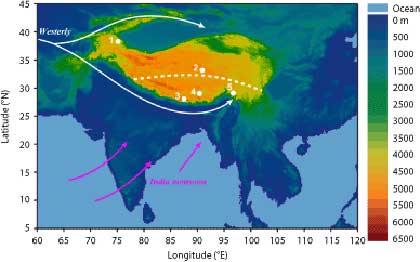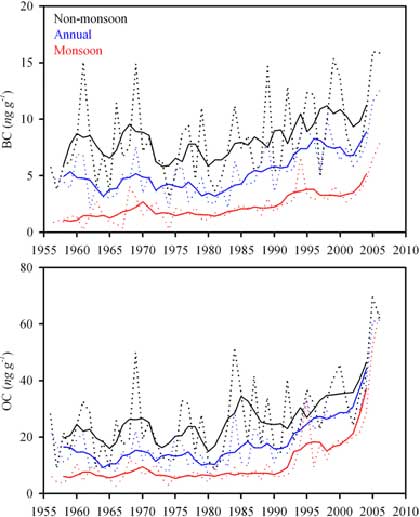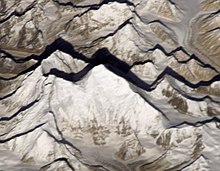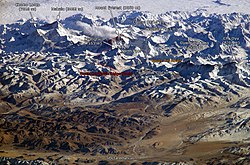世界第三極!西藏冰河正在倒退?
2013-05-13
Web only
作者:經濟學人
西藏及其周邊山區的冰量雖不如南北極,但還是相當可觀。該區擁有46,000條冰河,170萬平方公里的永凍層,厚度可達130公尺深。此區冰層的命運會直接影響非常多人,亞洲有十條大河的源頭在此,流域人口約為15億;歡迎來到地球的「第三極」。
第三極的研究非常有限,但在2009年時,青藏高原研究的姚檀棟、俄亥俄大學的Lonnie Thompson、森根堡世界生物多樣性聯盟的Volker Mosbrugger,開始推動了名為第三極環境(TPE)的計畫,上個月也舉行了第四次研討會。
去 年有項研究指出,西藏高源的冰河正在增加,但蘇黎士大學的Tobias Bolch表示,該研究所使用的衛星適於調查南北極,但不適合西藏高原這樣的山區。姚博士團隊的研究顯示,第三極的冰成湖自1970年代至今增加了約 26%;Bolch博士認為,先前研究中的衛星可能誤將這些湖泊當成冰河。
Bolch博士的團隊用另一種衛星調查之後,結論為許多西藏冰河 都在倒退,但也不是所有的冰河都在後退;姚博士和Thompson博士的研究指出,部分冰河確實有在前行,且大多位於西部的喀喇昆崙和帕米爾地區,但東部 的喜瑪拉牙和西藏高原的冰河則快速後退。總體而言,第三極的冰減少了許多。
研討會除了確認第三極的冰確實在減少之外,也顯示了該區的情況相當危險且資料不足。因此,中國科學院也撥出了4億人民幣的第三極研究資金。
去 年有項研究指出,西藏高源的冰河正在增加,但蘇黎士大學的Tobias Bolch表示,該研究所使用的衛星適於調查南北極,但不適合西藏高原這樣的山區。姚博士團隊的研究顯示,第三極的冰成湖自1970年代至今增加了約 26%;Bolch博士認為,先前研究中的衛星可能誤將這些湖泊當成冰河。
Bolch博士的團隊用另一種衛星調查之後,結論為許多西藏冰河 都在倒退,但也不是所有的冰河都在後退;姚博士和Thompson博士的研究指出,部分冰河確實有在前行,且大多位於西部的喀喇昆崙和帕米爾地區,但東部 的喜瑪拉牙和西藏高原的冰河則快速後退。總體而言,第三極的冰減少了許多。
研討會除了確認第三極的冰確實在減少之外,也顯示了該區的情況相當危險且資料不足。因此,中國科學院也撥出了4億人民幣的第三極研究資金。
Pages in category "Glaciers of Tibet"
The following 3 pages are in this category, out of 3 total. This list may not reflect recent changes (learn more).I
The Insukati Valley is China's largest glacier valley located on the northern slope of the Karakoram Range which is between Xinjiang and Pakistan.
The glacier found in this valley is about 41.5 kilometres long, covering an area of 392.4 square kilometres.[citationK
p to: navigation, search

Course of the Kangshung Glacier in the Mount Everest region
The common eastern face of Everest and Lhotse is called the Kangshung Face. Here, the Kangshung Glacier is fed and then flows through the Kangshung Valley towards the east. South of the glacier east of Lhotse lie the Pethangtse (6738 m) and the massif of the Makalu (8463 m) with its neighbouring peaks of Makalu II (7678 m - also called Kangshungtse) and Chomo Lonzo (7818 m), whose imposing north face hides the view of the main summit. The border between Nepal and China runs over this summit.
The east side of Mount Everest is the least accessible and developed side of the mountain. While the base camp on the Rongbuk Glacier can be accessed by jeep and the south side of Everest can be reached after a multi-day hike using fortified lodges for overnight stays, the Kangshung Glacier can only be reached following an approach march of several days, including a pass crossing.
R
The Rongbuk Glacier (simplified Chinese: 绒布冰川; traditional Chinese: 絨布冰川; pinyin: Róngbù Bīngchuān) is located in the Himalaya of southern Tibet. Two large tributary glaciers, the East and West Rongbuk Glaciers flow into the Rongbuk Glacier. It flows north and forms the Rongbuk Valley north of Mount Everest. The famous Rongbuk Monastery is located at the northern end of the Rongbuk valley. Mount Everest is the source of the Rongbuk Glacier and East Rongbuk Glacier.
Tibetan Glaciers Are Retreating
At An Alarming Rate
At An Alarming Rate
By James Hansen
20 December, 2009
Giss.nasa.gov
Giss.nasa.gov
Glaciers
on the Tibetan Plateau, sometimes called Earth's "third pole", hold the
largest ice mass outside the polar regions. These glaciers act as a
water storage tower for South and East Asia, releasing melt water in
warm months to the Indus, Ganges, Brahmaputra and other river systems,
providing fresh water to more than a billion people. In the dry season
glacial melt provides half or more of the water in many rivers.

Figure 1. Five
ice cores were extracted from the indicated locationson the Tibetan
plateau. The white dashed line is the northerly boundary of the Indian
monsoon.
Tibetan glaciers have been melting
at an accelerating rate over the past decade. Glacier changes depend on
local weather, especially snowfall, so glacier retreat or advance
fluctuates with time and place. Thus it is inevitable that some Tibetan
glaciers advance over short periods, as has been reported. But overall,
Tibetan glaciers are retreating at an alarming rate.
Global warming must be the primary
cause of glacier retreat, which is occurring on a global scale, but
observed rapid melt rates suggest that other factors may be involved. To
investigate the possible role of black soot in causing glacial melt, a
team of scientists from Chinese research institutes extracted ice cores
from five locations on the Tibetan Plateau (Figure 1).
Black soot, which includes black
carbon (BC) and organic carbon (OC), absorbs sunlight and can speed
glacial melting if BC reaches values of order 10 ng/g (nanograms per
gram) or larger. The ice core data revealed that BC reached values of
20-50 ng/g in the 1950s and 1960s for the four stations that are
downwind of European pollution sources. BC and OC amounts decreased
strongly in the early 1970s, probably because of clean air regulations
in Europe.
However, the ice cores also reveal
that in the past decade BC and OC began to increase again, even on the
Zuoqiupu glacier (Figure 2), which is mainly subject to Asian sources.
The data suggest that increased black soot arises from Asian sources,
especially the Indian subcontinent.
The measured concentrations of BC
and OC refer to fresh snow. But as the snow melts in the spring and
summer the black soot concentrations on the glacier surface increase,
because the soot particles do not escape in the melt water as
efficiently as the water itself. As a consequence, the soot noticeably
darkens the glacier surface during the melt season, increases absorption
of sunlight, and speeds glacier disintegration.


Figure 2. Black
carbon (BC) and organic carbon (OC) concentrations in the Zuoqiupu ice
core for the monsoon (June-Sept) and non-monsoon (Oct-May) seasons, and
the annual mean.
In a new paper by Xu et al., we
concluded that black soot is contributing to the rapid melt of glaciers
in the Himalayas. And continued, "business-as-usual" emissions of
greenhouse gases and black soot will result in the loss of most
Himalayan glaciers this century, with devastating effects on fresh water
supplies in dry seasons.
But business-as-usual emissions
are not inevitable. An alternative scenario, which stabilizes the
glaciers and has other benefits for global climate and human health,
requires a reduction of major human-made climate forcing agents that
have a warming effect — that means greenhouses gases, especially carbon
dioxide, as well as black soot.
Quantitative policy implications
have been defined: coal emissions must be phased out over the next 20
years, and unconventional fossil fuels, such as tar sands and oil shale,
must remain undeveloped. Combined with improved agricultural and
forestry practices and reduction of methane and black soot emissions,
these actions would avoid demise of the Tibetan glaciers.
Not coincidentally, these policy
actions are the same as those required to stabilize Earth's energy
balance and keep the climate near the Holocene climate range in which
civilization developed. The question is whether the global community can
exercise the free will to limit fossil fuel emissions and move to clean
energies of the future — or is it inevitable that all fossil fuels will
be burned?
The conclusion is that prospects
for survival of Tibetan glaciers can be much improved by reducing black
soot emissions. The black soot arises especially from diesel engines,
coal use without effective scrubbers, and biomass burning, including
cook stoves. Reduction of black soot via cleaner energies would have
other benefits for human health and agricultural productivity. However,
survival of the glaciers also requires halting global warming, which
depends upon stabilizing and reducing greenhouse gases, especially
carbon dioxide.
Related Links
NASA Earth Observatory: Image of the Day: 2009-12-15
NASA News Release: Black Carbon Deposits on Himalayan Ice Threaten Earth's "Third Pole"
NASA News Release: New Study Turns Up the Heat on Soot's Role in Himalayan Warming
References
Xu, B, J. Cao, J. Hansen, T. Yao, D.J. Joswia, N. Wang, G. Wu, M. Wang, H. Zhao, W. Yang, X. Liu, and J. He, 2009: Black soot and the survival of Tibetan glaciers. Proc. Natl. Acad. Sci., doi: 10.1073/pnas.0910444106, in press.
Hansen, J., Mki. Sato, P.
Kharecha, D. Beerling, R. Berner, V. Masson-Delmotte, M. Pagani, M.
Raymo, D.L. Royer, and J.C. Zachos, 2008: Target atmospheric CO2: Where should humanity aim? Open Atmos. Sci. J., 2, 217-231, doi:10.2174/1874282300802010217.
Contact
Please address all inquiries about this research to Dr. James Hansen.


沒有留言:
張貼留言